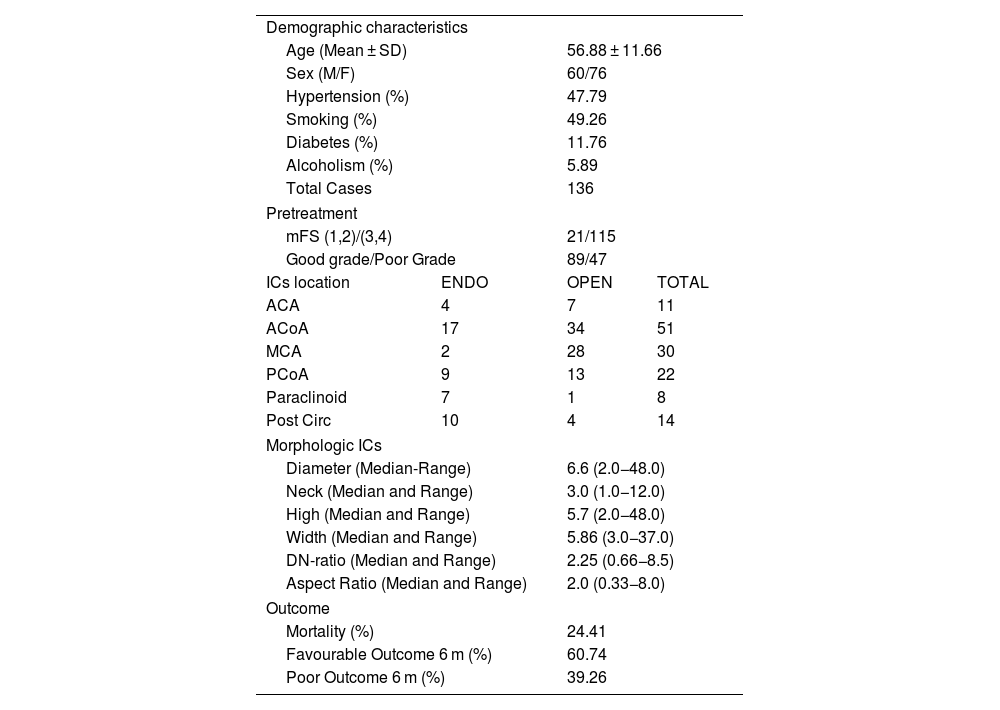In Europe, units with Dual-trained Neurovascular Surgeons (DTNS) skilled in both open neurosurgery (ON) and endovascular neurosurgery (EN) are scarce. For instance, in Spain, our unit is unique within the public health system, where all neurovascular procedures are carried out by DTNS. Our study aims to evaluate the evolution in treating ruptured intracranial aneurysms (rICAs) and assess the impact of this evolution on clinical outcomes.
MethodsA retrospective cohort study was performed on rICAs treated in our unit from October 2012 to June 2023. We reviewed clinical and radiological data to analyze the evolution of ON and EN over time, as well as their impact on patient outcomes. Univariate, multivariate, and mixed-effects models were utilized to discern temporal changes.
ResultsThe modified Fisher Scale (mFS) and the modified World Federation of Neurological Surgeons scale (mWFNS) showed strong correlation with the outcome at 6 months outcomes, both with p < 0.00001. However, the surgical intervention method, ON versus EN, did not significantly affect outcomes (p > 0.85). In adjusted multivariate logistic regression, mFS (−1.579, p: 0.011) and mWFNS (−0.872, p < 0.001) maintained their significance. rICAs location was significant when comparing ON to EN p = 0.0001. A significant temporal trend favored the selection of EN p = 0.0058). Mixed-effects time series modeling indicated that while patient characteristics and rICA specifics did not predict treatment choice, the year of treatment was significantly correlated (0.161, p = 0.002). Logistic regression with interaction terms for time and treatment type did not produce significant results.
ConclusionOur findings suggest that despite an increased adoption of EN techniques, there has been no change in patient outcomes. Even with the rise of EN, our unit continues to perform ON for a higher proportion of rICAs than most national hospitals. We propose that a “dual approach” offers advantages in a patient individualized treatment decision protocol in the European context.
En Europa, las unidades con Cirujanos Neurovasculares de Doble Formación (DTNS) capacitados tanto en neurocirugía abierta (ON) como en neurocirugía endovascular (EN) son escasas. Por ejemplo, en España, nuestra unidad es única dentro del sistema público de salud, donde todos los procedimientos neurovasculares son realizados por DTNS. Nuestro estudio tiene como objetivo evaluar la evolución en el tratamiento de aneurismas intracraneales rotos (rICAs) y evaluar el impacto de esta evolución en los resultados clínicos.
MétodosSe ha realizado un estudio de cohorte retrospectivo sobre rICAs tratados en nuestra unidad desde octubre de 2012 hasta junio de 2023. Revisamos datos clínicos y radiológicos para analizar la evolución de ON y EN a lo largo del tiempo, así como su impacto en los resultados de los pacientes. Se utilizaron modelos univariados, multivariados y de efectos mixtos para discernir cambios temporales.
ResultadosLa Escala Fisher modificada (mFS) y la Escala de la Federación Mundial de Cirujanos Neurológicos modificada (mWFNS) mostraron una fuerte correlación con el resultado a los 6 meses, ambos con p < 0.00001. Sin embargo, el método de intervención quirúrgica, ON versus EN, no afectó significativamente los resultados (p > 0.85). En la regresión logística multivariada ajustada, mFS (−1.579, p: 0.011) y mWFNS (−0.872, p < 0.001) mantuvieron su significancia. La ubicación de los rICAs fue significativa al comparar ON con EN (p = 0.0001). Se observó una tendencia temporal significativa a favor de la selección de EN (p = 0.0058). La modelización de series temporales de efectos mixtos indicó que, mientras las características de los pacientes y los detalles específicos de los rICA no predecían la elección del tratamiento, el año del tratamiento estaba significativamente correlacionado (0.161, p = 0.002). La regresión logística con términos de interacción para el tiempo y el tipo de tratamiento no produjo resultados significativos.
ConclusiónNuestros hallazgos sugieren que, a pesar de una adopción creciente de técnicas EN, no ha habido un cambio en los resultados de los pacientes. Incluso con el auge de EN, nuestra unidad continúa realizando ON para una mayor proporción de rICAs que la mayoría de los hospitales nacionales. Proponemos que un "enfoque dual" ofrece ventajas en un protocolo de decisión de tratamiento individualizado para pacientes en el contexto europeo.
Article

If it is the first time you have accessed you can obtain your credentials by contacting Elsevier Spain in suscripciones@elsevier.com or by calling our Customer Service at902 88 87 40 if you are calling from Spain or at +34 932 418 800 (from 9 to 18h., GMT + 1) if you are calling outside of Spain.
If you already have your login data, please click here .
If you have forgotten your password you can you can recover it by clicking here and selecting the option ¿I have forgotten my password¿.











